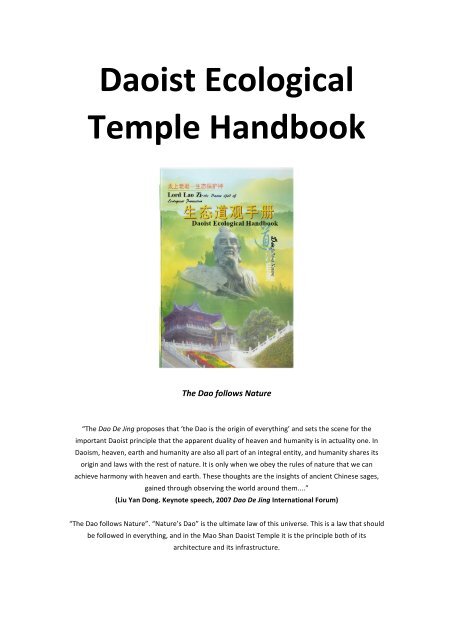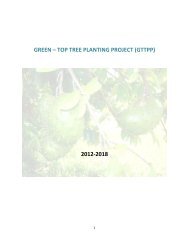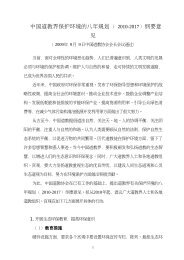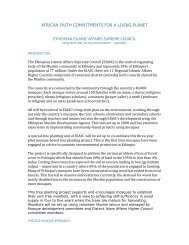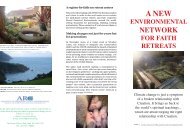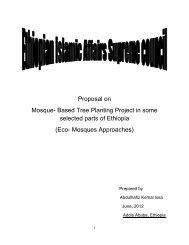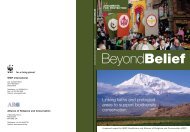Daoist Ecological Temple Handbook - Alliance of Religions and ...
Daoist Ecological Temple Handbook - Alliance of Religions and ...
Daoist Ecological Temple Handbook - Alliance of Religions and ...
Create successful ePaper yourself
Turn your PDF publications into a flip-book with our unique Google optimized e-Paper software.
<strong>Daoist</strong> <strong>Ecological</strong> <br />
<strong>Temple</strong> <strong>H<strong>and</strong>book</strong> <br />
The Dao follows Nature <br />
“The Dao De Jing proposes that ‘the Dao is the origin <strong>of</strong> everything’ <strong>and</strong> sets the scene for the <br />
important <strong>Daoist</strong> principle that the apparent duality <strong>of</strong> heaven <strong>and</strong> humanity is in actuality one. In <br />
Daoism, heaven, earth <strong>and</strong> humanity are also all part <strong>of</strong> an integral entity, <strong>and</strong> humanity shares its <br />
origin <strong>and</strong> laws with the rest <strong>of</strong> nature. It is only when we obey the rules <strong>of</strong> nature that we can <br />
achieve harmony with heaven <strong>and</strong> earth. These thoughts are the insights <strong>of</strong> ancient Chinese sages, <br />
gained through observing the world around them....” <br />
(Liu Yan Dong. Keynote speech, 2007 Dao De Jing International Forum) <br />
“The Dao follows Nature”. “Nature’s Dao” is the ultimate law <strong>of</strong> this universe. This is a law that should <br />
be followed in everything, <strong>and</strong> in the Mao Shan <strong>Daoist</strong> <strong>Temple</strong> it is the principle both <strong>of</strong> its <br />
architecture <strong>and</strong> its infrastructure.
LIST OF CONTENTS <br />
LIST OF CONTENTS <br />
2 <br />
PART 1: ECOLOGICAL TEACHINGS FROM GREAT DAOIST PHILOSOPHERS <br />
A) MORNING PRAYERS......................................................................................................................... 3 <br />
— DAO DE JING CHAPTER 51...............................................................................................................................3 <br />
— TAIPING JING, THE CLASSIC OF GREAT PEACE..............................................................................................3 <br />
B) AFTERNOON PRAYERS..................................................................................................................... 4 <br />
— THE YELLOW EMPEROR’S BOOK OF HIDDEN HARMONIES........................................................................4 <br />
C) EVENING PRAYERS........................................................................................................................... 4 <br />
— THE ONE HUNDRED AND EIGHTY COMMANDMENTS OF LAOZI................................................................4 <br />
PART 2: CASE STUDIES <br />
1. THE LONGMEN CAVE DAOIST TEMPLE ........................................................................................... 5 <br />
2. THE WHITE CLOUD TEMPLE........................................................................................................... 5 <br />
3. ZHEN WU GUAN ............................................................................................................................... 6 <br />
4. THE KONGTONG MOUNTAIN ........................................................................................................... 6 <br />
PART 3: ADDRESSING ECO-‐PROBLEMS IN DAOIST TEMPLES TODAY <br />
1. INCENSE – THREE STICKS ARE ENOUGH........................................................................................... 7 <br />
2. LOOKING AFTER OUR TEMPLES ....................................................................................................... 7 <br />
3. GREENING AND BEAUTIFYING THE ENVIRONMENT......................................................................... 8 <br />
4. MAKING A PLEDGE ........................................................................................................................... 8 <br />
5. PROTECTING ANIMALS..................................................................................................................... 8 <br />
6. PRESERVING WATER SOURCES ........................................................................................................ 8 <br />
7. IMPROVING TOILET FACILITIES ....................................................................................................... 9 <br />
8. PERSONAL HYGIENE......................................................................................................................... 9 <br />
9. TECHNOLOGICAL METHODS ............................................................................................................ 9 <br />
10. ENVIRONMENTAL CAMPAIGN........................................................................................................ 9 <br />
PART 4: BUILDING DAOIST ECOLOGICAL TEMPLES 9 <br />
1. THE TIEJIA DAOIST ECOLOGICAL TEMPLE, 2005 .......................................................................10 <br />
2. WO YUNSHAN DAOIST TEMPLE.....................................................................................................10 <br />
3 <br />
5 <br />
7 <br />
PART 5. SIMPLE ADVICE TO THE FOLLOWERS OF DAOISM <br />
BACKGROUND INFORMATION <br />
10 <br />
12
Part 1: <strong>Ecological</strong> Teachings from Great <strong>Daoist</strong> Philosophers <br />
This is divided into sections for the morning, afternoon <strong>and</strong> evening. The material <br />
can be chanted, spoken, or simply read. <br />
a) Morning Prayers <br />
— Dao De Jing Chapter 51 <br />
Everything streams from the Dao (the way), <br />
Everything is nurtured by De (virtue). <br />
Everything is made out <strong>of</strong> substance. <br />
Everything is created by the Dao <strong>of</strong> Nature <br />
– <strong>and</strong> from everything on earth that surrounds it. <br />
So every living thing should bow to the Dao <strong>and</strong> the De <br />
Because they are what it is. <br />
Everything that breathes comes from the Dao <br />
And the Virtue feeds <strong>and</strong> takes care <strong>of</strong> it. <br />
They grace things without possessing them, <br />
They benefit everything but ask for nothing back, <br />
They give themselves into everything without seeking control. <br />
This is the essence <strong>of</strong> the original intention. <br />
When the great <strong>Daoist</strong> master Laozi spoke <strong>of</strong> Dao <strong>and</strong> De in what became known the <br />
Dao De Jing (the Scripture <strong>of</strong> the Way <strong>and</strong> <strong>of</strong> Virtue) he was from the very beginning <br />
implying that people should be conscious <strong>of</strong> our behaviour towards nature, as part <strong>of</strong> <br />
our search for the essential meaning <strong>of</strong> our lives. Gracing things without possessing <br />
them, benefiting everything but asking for nothing back: these are great models for <br />
our relationship to each other <strong>and</strong> to the natural world. <br />
— Taiping Jing, the Classic <strong>of</strong> Great Peace <br />
Heaven, in charge <strong>of</strong> birth, is called “Father”. <br />
Earth, in charge <strong>of</strong> nourishment, is called “Mother”. <br />
Humanity, managing everything that the Father gives birth to, is called “the Son”. <br />
Father gives orders to humanity through the shifting <strong>of</strong> seasons <strong>and</strong> winds, <br />
Mother follows the Father to provide nourishment, <br />
“Son” bears the authority <strong>of</strong> his Father since birth, <strong>and</strong> takes nourishment from his Mother… <br />
Heaven gives birth to humanity, <strong>and</strong> earth nourishes his form;
But humanity is stupid <strong>and</strong> foolish — he disrespects his Father <strong>and</strong> Mother. <br />
His Father <strong>and</strong> Mother are both unhappy; <br />
Millions <strong>of</strong> living things, including people, are dying. <br />
Humanity did not apply the rule <strong>of</strong> Dao <strong>and</strong> Reason — that is the root <strong>of</strong> all the blame. <br />
Heaven <strong>and</strong> Earth are Father <strong>and</strong> Mother to humanity. <br />
The Son, instead <strong>of</strong> loving his Father <strong>and</strong> Mother, steals from them, hurts them, <strong>and</strong> sickens <br />
them — all <strong>of</strong> these are not small crimes. <br />
The Taiping Jing observes that the survival <strong>of</strong> humankind depends on nature. It <br />
recognises the damage that many <strong>of</strong> human activities have caused, <strong>and</strong> warns <br />
against any future disrespectful behaviour, <strong>and</strong> encourages people to show their <br />
awe <strong>and</strong> love to nature. It was written more than 2,000 years ago <br />
b) Afternoon Prayers <br />
— The Yellow Emperor’s Book <strong>of</strong> Hidden Harmonies <br />
Heaven <strong>and</strong> Earth are the plunderers <strong>of</strong> all things: all things are the plunderers <strong>of</strong> humans; <strong>and</strong> <br />
humans are the plunderers <strong>of</strong> all things. When the three plunderers mutually act on each other, <br />
they are at rest. Hence it is said, 'One who lives eating <strong>and</strong> drinking according to time <strong>and</strong> season <br />
will be in good health. Taking action at key time brings peace to all things. <br />
This text describes the inter-‐dependent relationships <strong>of</strong> heaven, humanity, <strong>and</strong> <br />
nature. Even two thous<strong>and</strong> years ago there was already an ancient wisdom that <br />
realised the importance <strong>of</strong> ecological systems <strong>and</strong> a dynamic balance <strong>of</strong> nature’s <br />
elements. <br />
c) Evening Prayers <br />
— The One Hundred <strong>and</strong> Eighty Comm<strong>and</strong>ments <strong>of</strong> Laozi <br />
Do not kill or hurt any life. <br />
Do not cage birds <strong>and</strong> animals. <br />
Do not casually climb trees to destroy nests. <br />
Do not whip domestic animals. <br />
Do not casually cut trees. <br />
Do not remove <strong>and</strong> steal the flowers. <br />
Do not burn wild fields <strong>and</strong> forests. <br />
Do not reclaim l<strong>and</strong> casually, <br />
<strong>and</strong> do not thereby damage the mountains <strong>and</strong> rivers. <br />
Do not dry the water courses.
The One Hundred <strong>and</strong> Eighty Comm<strong>and</strong>ments <strong>of</strong> Laozi is the most important book <strong>of</strong> <br />
comm<strong>and</strong>ments in Daoism. It includes many ecology-‐related rules <strong>and</strong> guidelines. <br />
For instance, a good person should have compassion for all living things, protect <br />
natural resources, <strong>and</strong> preserve the environment that nurtures <strong>and</strong> sustains our <br />
lives. <br />
Part 2: Case studies <br />
The following are among the many traditional <strong>Daoist</strong> <strong>Temple</strong>s that have instituted <br />
good ecological management <strong>and</strong> can act as models for others. <br />
1. The Longmen Cave <strong>Daoist</strong> <strong>Temple</strong> <br />
The temple is located on Mt Longmen, in Shaanxi Province. The mountain is a typical <br />
karst l<strong>and</strong>scape, with 35 natural caves <strong>and</strong> 24 lakes. Local legend tells <strong>of</strong> how every <br />
cave houses a xian (fairy immortal), <strong>and</strong> every lake a dragon. Trees thrive over the <br />
mountain, <strong>and</strong> it is lush with wildflowers. The beauty <strong>of</strong> this place attracts believers <br />
<strong>and</strong> pilgrims to come <strong>and</strong> meditate, as they have done since ancient times. <br />
The temple is beautifully adapted to the local topography <strong>and</strong> scenery. Where there <br />
is water, a bridge was built; where there is a cave, a shrine was built; by the road <br />
along which pilgrims travelled, taverns were set up, <strong>and</strong> on large rocks, poems <strong>and</strong> <br />
characters were engraved. The entire temple is hidden among thick trees <strong>and</strong> <br />
bamboo, <strong>and</strong> its buildings share <strong>and</strong> enhance the beauty <strong>of</strong> its surroundings. <br />
Although other <strong>Daoist</strong> temples do not have such an ideal environment as this one, <br />
the monks <strong>and</strong> nuns who have lived there over the centuries have <strong>of</strong>ten tried to <br />
better their surroundings by creating peaceful <strong>and</strong> beautiful gardens, <strong>and</strong> planting <br />
trees <strong>and</strong> flowers. Planting trees <strong>and</strong> guarding forests have become traditions <strong>of</strong> <br />
<strong>Daoist</strong> temples. Indeed, many temples tell stories <strong>of</strong> how fairy immortals <strong>and</strong> men <br />
with great virtues used to plant trees to show their respect to nature. <br />
2. The White Cloud <strong>Temple</strong> <br />
The Yellow Earth Plateau has experienced serious soil erosion. Where thous<strong>and</strong>s <br />
years before there were forests, today there are just barren ditches <strong>and</strong> trenches <br />
resulting from years <strong>of</strong> ecological damage. However, the White Cloud <strong>Temple</strong> in Jia <br />
County, Shaanxi Province, is blessed by lush plants <strong>and</strong> enchanted by the singing <strong>of</strong> <br />
birds attracted by its serenity. It was enshrined as the “Green Pearls <strong>of</strong> the Yellow <br />
River Valley”. Now, the temple covers an area <strong>of</strong> 81 thous<strong>and</strong> mu (5,400 hectares),
<strong>of</strong> which two thirds are green, planted by <strong>Daoist</strong>s over hundreds <strong>of</strong> years. <br />
3. Zhen Wu Guan <br />
The Mountain <strong>of</strong> Five Phoenixes is located in Gansu Province in northwest China. Its <br />
steep <strong>and</strong> rocky topography makes it very difficult to plant trees. In order to bring <br />
peace to this area, a <strong>Daoist</strong> temple, Zhen Wu Guan, was built on the top <strong>of</strong> this <br />
mountain in the mid-‐Qing period (around the 18 th century). From the very beginning, <br />
the <strong>Daoist</strong> master <strong>of</strong> the temple “searched for suitable seedlings <strong>of</strong> cyprus <strong>and</strong> pine <br />
trees, <strong>and</strong> planted them, where suitable, with wintergreens, poplars <strong>and</strong> flowers <br />
such as peonies, which are native to this area. From the top <strong>of</strong> the mountain to the <br />
Hall <strong>of</strong> the God <strong>of</strong> Wind, he planted one hundred <strong>and</strong> fourteen trees.” <br />
Later on he created rules prohibiting people from doing anything damaging to the <br />
forest; <strong>and</strong> to remind them, he preached regularly to the local villagers <strong>and</strong> engraved <br />
these prohibitions on rocks. Today, more than 200 years later, the young trees he <br />
planted have grown into forests that cover thous<strong>and</strong>s <strong>of</strong> mu, <strong>and</strong> serve as green <br />
barriers protecting the neighbouring areas. <br />
Ancient <strong>Daoist</strong> temples, blessed with the authority <strong>of</strong> God, <strong>and</strong> sometimes assisted <br />
by the power <strong>of</strong> local authorities, built around themselves natural conservations <strong>and</strong> <br />
forest reserves. Emperors throughout Chinese history issued laws <strong>and</strong> instructions to <br />
protect these <strong>Daoist</strong> sacred l<strong>and</strong>s, forbidding people from cutting trees <strong>and</strong> hunting <br />
animals in these areas. <br />
4. The Kongtong Mountain <br />
The plateau to the northeast <strong>of</strong> Shaanxi province is piled up by thick yellow earth, on <br />
which many barren mountains st<strong>and</strong>. Only the sacred Kongtong Mountain, a few <br />
kilometres west <strong>of</strong> Pingliang City, on the edge <strong>of</strong> Gansu Province, is covered by thick <br />
forest. The lovely thriving greenery is no less lively than the fertile river towns south <br />
<strong>of</strong> the Yangzi River, <strong>and</strong> the scenery with its peaks <strong>and</strong> pines <strong>and</strong> jagged rocks is an <br />
important destination for pilgrimage. In the Book <strong>of</strong> Zhuangzi it is told that the <br />
Yellow Emperor heard <strong>of</strong> Master Guangcheng, who was living on top <strong>of</strong> the <br />
Kongtong mountain, <strong>and</strong> he went to see him saying: “I underst<strong>and</strong> that you have <br />
found the perfect Dao: I dare to ask you what is the essence <strong>of</strong> the perfect Dao” <br />
And the Master replied: “What you ask about is the true element <strong>of</strong> all things: what <br />
you seek control over is in essence divided. Since you began governing all below <br />
Heaven, the breath <strong>of</strong> the clouds has not yet formed <strong>and</strong> yet it rains; the trees <strong>and</strong> <br />
bushes drop their leaves before they have turned yellow; the light <strong>of</strong> the sun <strong>and</strong> <br />
moon grows ever weaker. You are a man whose heart has become numbed by <br />
words… It would be unworthy to teach you the Dao.”
The Yellow Emperor goes into meditation, <strong>and</strong> it is only when he returns to Kongtong <br />
Mountain after this that he is allowed to learn that the essence <strong>of</strong> the perfect Dao is <br />
hidden in darkness. As is written in The Yellow Emperor’s Book <strong>of</strong> Hidden Harmonies: <br />
“Be still, be pure, do not make your body struggle, do not disturb your essence.” <br />
Daoism advocates a harmonious relationship between humanity <strong>and</strong> nature’s other <br />
creations. One <strong>of</strong> its important principles is “benevolence towards birds <strong>and</strong> beasts”; <br />
henceforth, it forbids killing <strong>and</strong> eating meat. Combined with the dynamic ecological <br />
balance maintained around <strong>Daoist</strong> temples, <strong>Daoist</strong>s are able to enjoy a good <br />
relationship with all kinds <strong>of</strong> wildlife. <br />
Part 3: Addressing eco-‐problems in <strong>Daoist</strong> <strong>Temple</strong>s today <br />
Why does Daoism pay such intense attention to ecological conservation This is <br />
because Daoism realises, humanity, nature, <strong>and</strong> nature’s other creations, are <strong>of</strong> one <br />
integral <strong>and</strong> inter-‐dependent entity. If any harm is done to the environment, <br />
humanity cannot escape unscathed <strong>and</strong> unpunished. We have to live together, to <br />
live better; <strong>and</strong> we have to live better, <strong>and</strong> to prosper together. <br />
1. Incense – three sticks are enough <br />
Some believers misunderst<strong>and</strong> some <strong>of</strong> the ancient <strong>Daoist</strong> religious practices. For <br />
instance, incense burning is a ritual which not only shows respect to the deities, but <br />
also has traditionally served the useful environmental function <strong>of</strong> expelling bugs such <br />
as mosquitoes. However, recently people have started burning huge amounts <strong>of</strong> <br />
incense, sometimes in great bonfires, in the hope <strong>of</strong> getting more attention from the <br />
gods. However, the incense they burn is sometimes <strong>of</strong> poor quality <strong>and</strong> by burning it <br />
in that quantity it damage the environment through smoke pollution as well as <br />
damaging the lungs <strong>of</strong> other worshippers <strong>and</strong> <strong>of</strong> the monks, nuns <strong>and</strong> lay staff who <br />
live in the temple all the time. <br />
Burning incense, prayer papers <strong>and</strong> wax, <strong>and</strong> lighting fireworks <strong>and</strong> crackers, are <br />
important rituals in <strong>Daoist</strong> religious ceremonies. Today, <strong>Daoist</strong> temples advocate the <br />
practice <strong>of</strong> “burning three incense with utmost sincerity as the way to pay respect to <br />
Gods”. This method has already demonstrated to be very effective in reducing <br />
pollution, as well as giving a message that high consumption <strong>and</strong> extravagance are <br />
not something that the gods support. <br />
2. Looking after our temples <br />
As <strong>Daoist</strong>s, we need to consider it our responsibility <strong>and</strong> obligation to protect the <br />
environment around our temples. We need to develop good personal habits, keep <br />
our temples clean, recycle garbage, reduce pollution, maintain biodiversity, <strong>and</strong> <br />
protect plants <strong>and</strong> water sources. We need to also reach out to the tourists <strong>and</strong>
elievers, for instance, by h<strong>and</strong>ling out environmental h<strong>and</strong>books, to help them <br />
realise this is their responsibility as well. <br />
Keeping the environment clean is the daily duty <strong>of</strong> all <strong>Daoist</strong>s. They take very good <br />
care <strong>of</strong> the temple, so very little garbage is produced from within. They also <br />
voluntarily clean up the garbage outside the temple. Because <strong>of</strong> this, <strong>Daoist</strong> temples <br />
are held by many as peaceful, sacred <strong>and</strong> clean sanctuaries. <br />
3. Greening <strong>and</strong> beautifying the environment <br />
Planting trees <strong>and</strong> flowers are considered by <strong>Daoist</strong>s as being actions <strong>of</strong> great merit <br />
<strong>and</strong> therefore are carried out voluntarily. <strong>Daoist</strong> followers are increasingly taking on <br />
responsibilities to clean the neighbouring forests, guarding them against fire, but <br />
also consciously beautifying the environment inside <strong>and</strong> outside the temple by <br />
planting <strong>and</strong> protecting trees <strong>and</strong> shrubs. If the environment is beautiful, then <br />
people will want to protect it. <br />
4. Making a pledge <br />
The Qinling Declaration, made in 2006 at Taibaishan in the Qinling Mountains, <br />
involved all the participants (representing monasteries <strong>and</strong> nunneries throughout <br />
China) promising to: <br />
bring ecological education into temples <br />
reduce pollution caused by incense burners, etc <br />
use farmed l<strong>and</strong> sustainably <br />
protect species <strong>and</strong> forests <br />
save energy <br />
protect water resources. <br />
5. Protecting animals <br />
Daoism asks its believers to love life, <strong>and</strong> not just their own. It advocates that: <br />
“Benevolence be extended to all lives” <strong>and</strong> respect shown to all <strong>of</strong> nature’s creations. <br />
Because <strong>of</strong> this, birds <strong>and</strong> beasts are able to live happily around many temples, <br />
enjoying protection <strong>and</strong> sometimes assistance from the <strong>Daoist</strong> masters. <br />
6. Preserving water sources <br />
“The highest kind is like that <strong>of</strong> water”. <strong>Daoist</strong> teachings exhibit great love <strong>and</strong> <br />
respect towards water, which has the merit to “nurture all things” <strong>and</strong> is the origin <br />
<strong>of</strong> all lives. All <strong>Daoist</strong> temples adopt practices to save water, set up appropriate <br />
facilities to protect the sources <strong>and</strong> assign people to check, fix <strong>and</strong> clean the <br />
reservoirs <strong>and</strong> nearby environment. They also set up signs to remind tourists to save <br />
water <strong>and</strong> protect water sources as well.
7. Improving toilet facilities <br />
The toilet is “the place where the food cycle ends <strong>and</strong> mosquitoes thrive”. To make <br />
<strong>Daoist</strong> temples ecological, an urgent task is to improve the toilet facilities. By using <br />
water to flush, or earth to bury, we try not to produce pollution a second time. Our <br />
slogan is, “an ecological <strong>Daoist</strong> temple does not produce flies”! <br />
8. Personal Hygiene <br />
To be a respectful follower <strong>of</strong> the Dao, one needs not only to cultivate from within, <br />
but also take advantage <strong>of</strong> the proper facilities to maintain physical well-‐being. <br />
Therefore, to build <strong>Daoist</strong> ecological temples, it is also important to improve the <br />
accommodation <strong>and</strong> bathing facilities. <br />
9. Technological Methods <br />
Technological support is needed in building <strong>Daoist</strong> ecological temples. The <strong>Daoist</strong> <br />
temples in northern Shaanxi Province have cooperated with many forestry experts to <br />
launch research projects <strong>and</strong> experiments in order to develop trees that can adapt to <br />
the harsh local environment; Huashan has introduced environmentally friendly <br />
toilets <strong>and</strong> sewage treatment systems from Germany to reduce pollution caused by <br />
the thriving tourist industry; Louguan Tai has installed solar lights, <strong>and</strong> Jinxian <br />
<strong>Temple</strong> has set up solar water heaters; <strong>and</strong> Mingsheng Hall is preparing to install <br />
spraying facilities to reduce the dust pollution. <br />
It is expensive to install such environmental technologies; therefore it has not been <br />
the most common practice <strong>of</strong> all <strong>Daoist</strong> temples. However, we look forward to such <br />
opportunities in the future as it will help us to improve our ecological temples. <br />
Louguan Tai has solar-‐powered street lights, which, in the words <strong>of</strong> one <strong>Daoist</strong> <br />
Master, “take a nap under the sun during the day, <strong>and</strong> shine more brightly than the <br />
moon during the night”. <br />
10. Environmental Campaign <br />
Apart from getting directly involved in environmental activities, some <strong>of</strong> the <strong>Daoist</strong> <br />
temples have launched campaigns on environmental conservation, including setting <br />
up training programmes for residents inside the temple, preaching environmental <br />
concepts through prayers <strong>and</strong> ceremonies, holding exhibitions on ecological <br />
conservation, <strong>and</strong> installing environmental signs <strong>and</strong> slogans. <br />
Part 4: Building <strong>Daoist</strong> <strong>Ecological</strong> <strong>Temple</strong>s <br />
<strong>Daoist</strong> <strong>Ecological</strong> <strong>Temple</strong>s should be built taking into consideration the 10 steps <br />
outlined in the previous section. Increasing numbers <strong>of</strong> <strong>Daoist</strong> monks <strong>and</strong> nuns want
to live in, <strong>and</strong> run, their temples according to <strong>Daoist</strong> environmental principles. <br />
1. The Tiejia <strong>Daoist</strong> <strong>Ecological</strong> <strong>Temple</strong>, 2005 <br />
This is located on the southern hillside <strong>of</strong> Taibai Mountain, in Shaanxi Province. It <br />
was built between 2005 <strong>and</strong> 2007 in a collaboration between the Louguantai <strong>Temple</strong>, <br />
which traditionally manages the sacred Taibai Mountain, together with the <strong>Alliance</strong> <br />
<strong>of</strong> <strong>Religions</strong> <strong>and</strong> Conservation (ARC) <strong>and</strong> Dutch funder the <strong>Ecological</strong> Management <br />
Foundation (EMF). From the very beginning, this temple has lived up to its <br />
environmentally friendly <strong>and</strong> nature-‐loving expectations. <br />
It is a peaceful paradise for pilgrims, guests <strong>and</strong> tourists to come <strong>and</strong> meditate at the <br />
foot <strong>of</strong> the pilgrim trail, but it is not just that; it is also a showcase for <strong>Daoist</strong> <br />
ecological concepts. Together with the neighboring P<strong>and</strong>a Lodges, run by <br />
WWF-‐China, it has run several ecological training programmes <strong>and</strong> study groups. In <br />
2006 <strong>and</strong> 2007, this place has witnessed the first <strong>Daoist</strong> ecological workshops in <br />
China. They resulted in the founding <strong>of</strong> a new <strong>and</strong> powerful <strong>Daoist</strong> ecological <strong>and</strong> <br />
educational alliance, <strong>and</strong> the publication <strong>and</strong> agreement <strong>of</strong> the Qinling Declaration, <br />
aimed at protecting the ecological system. Initiatives have also been launched to <br />
warship Laozi as the God <strong>of</strong> environmental protection. <br />
At the base <strong>of</strong> the pilgrimage trail, <strong>and</strong> at the gate <strong>of</strong> the <strong>Ecological</strong> <strong>Temple</strong>, a <br />
thous<strong>and</strong>-‐year old Iron Armour tree (tiejia) still st<strong>and</strong>s as the evidence <strong>of</strong> what <br />
Daoism has <strong>and</strong> has been, trying to protect. It has seen many ups <strong>and</strong> downs <strong>and</strong> <br />
reversals <strong>of</strong> history. <br />
2. Wo Yunshan <strong>Daoist</strong> temple <br />
Wo Yunshan <strong>Daoist</strong> temple is located between the southern edges <strong>of</strong> Mu Us Desert <br />
<strong>and</strong> the Yellow Earth Plateau. It was until recently surrounded by around 3,000 mu <br />
(200 hectares) <strong>of</strong> s<strong>and</strong>y desert-‐like l<strong>and</strong>, with very little planted. Starting in 1995, the <br />
temple’s management committee, following the suggestions <strong>of</strong> forestry experts, <br />
managed to build a collectively-‐owned botanical garden in this area. The botanical <br />
garden, which is also now a provincial science demonstration base for local villagers, <br />
currently grows 1,824 different kinds <strong>of</strong> plants, from 130 families <strong>and</strong> 440 genera, <strong>of</strong> <br />
which 60 are endangered species. <br />
Part 5. Simple Advice to the followers <strong>of</strong> Daoism <br />
Sharing effective ways <strong>of</strong> preserving our environment <br />
“The goodness <strong>of</strong> water is that it benefits the ten thous<strong>and</strong> creatures; yet itself <br />
does not scramble, but is content with the places that all men disdain. It is this
makes water so near to the Way…” — To see Dao, one must first learn from <br />
water, nurturing all things <strong>and</strong> creating a “good place”. <br />
“The highest kind is like that <strong>of</strong> water.” — Water is the origin <strong>of</strong> all lives. Please <br />
protect our water sources, <strong>and</strong> save water in your daily life. The water we used <br />
to wash vegetables can be used to water your flowers; <strong>and</strong> the water we used to <br />
wash your clothes, can be used to flush our toilets <strong>and</strong> clean our floors! <br />
“The sage nurtures all, <strong>and</strong> ab<strong>and</strong>ons no one, he accepts (saves) everything <strong>and</strong> <br />
rejects (throws) nothing, he attends to the smallest details.” — There exists no <br />
real “waste” in the world. Please separate your garbage <strong>and</strong> recycle it. <br />
“Though there be boats <strong>and</strong> carriages, none being there to ride them.” — Please <br />
choose transportation that does not pollute our environment. Please walk when <br />
you can, this is better for your health. <br />
To preserve our forest, please choose recycled paper <strong>and</strong> print your document <br />
on both sides <strong>of</strong> the paper. <br />
The incense you burn does not have to be big <strong>and</strong> plenty. Please choose <br />
environmentally friendly incense. Suffocating smoke could discredit your <br />
sincerity <strong>and</strong> harm your health. <br />
Please take away the litter you leave behind when travelling. <br />
Everyone has the responsibility to protect our environment. Please remember, <br />
there is always more you can do!
BACKGROUND INFORMATION <br />
This h<strong>and</strong>book was written for the third <strong>Daoist</strong> <strong>Ecological</strong> Workshop held at <br />
Jurong in 2008. Two hundred copies <strong>of</strong> the Chinese version were distributed to <br />
the 200 <strong>Daoist</strong> monks <strong>and</strong> nuns who attended. <br />
This very succesfull workshop was held with the support <strong>of</strong> <strong>Alliance</strong> <strong>of</strong> <strong>Religions</strong> <br />
<strong>and</strong> Conservation (ARC), the <strong>Ecological</strong> Management Fund (EMF), WWF <br />
International <strong>and</strong> WWF-‐UK. It was held with the generous encouragement <strong>and</strong> <br />
assistance by the municipal government <strong>of</strong> Jurong, the Maoshan Management <br />
Committee, Jurong’s Bureau <strong>of</strong> Ethnic <strong>and</strong> Religious Affairs <strong>and</strong> related <br />
organisations. To them, we express our sincere gratitude. <br />
Planning: Fan Guangchun <br />
He Xiaoxin <br />
Martin Palmer <br />
Ren Xingzhi <br />
Yang Shihua <br />
Editing: Pan Cunjuan <br />
Zhang Fang <br />
Designing: Zhao Hua <br />
Producing: Maoshan <strong>Daoist</strong> <strong>Temple</strong>, Jurong, Jiangsu Province <br />
<strong>Daoist</strong> Research Center, Shaangxi Academy <strong>of</strong> Social Sciences


